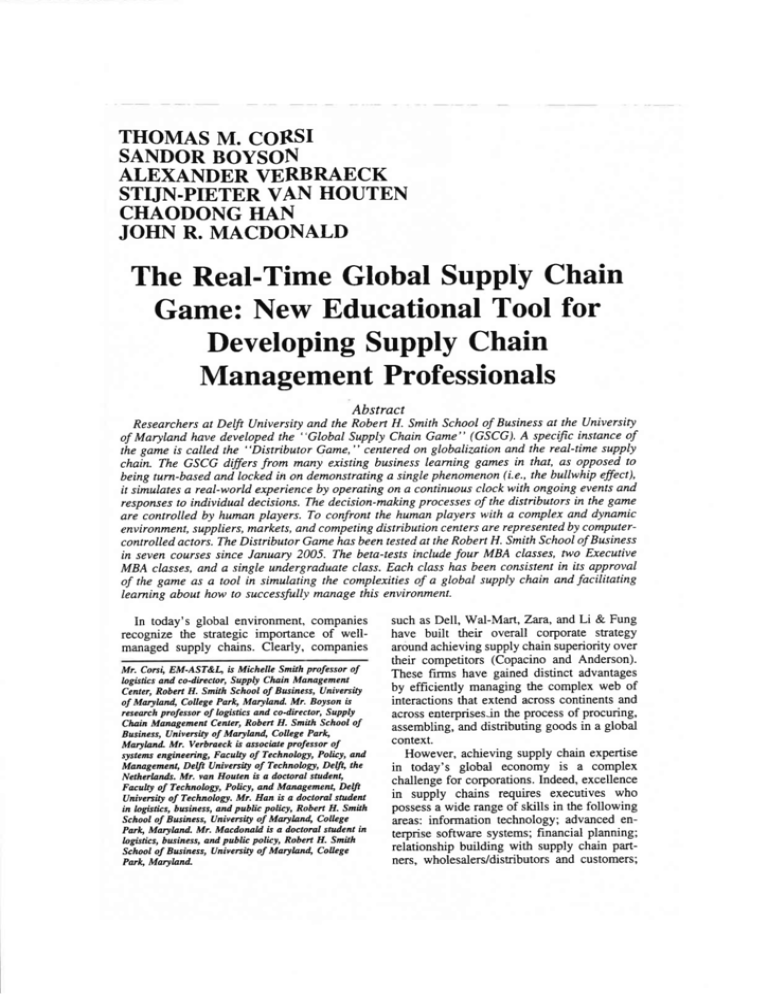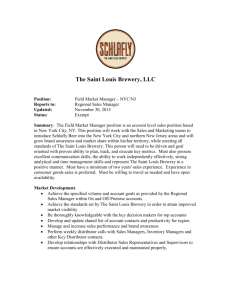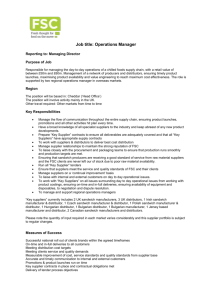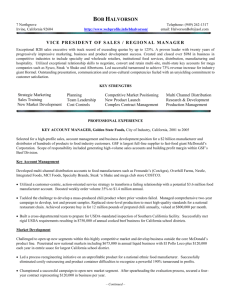The Real-Time Global Supply Chain Game: New Educational Tool
advertisement

THOMAS M. CORSI SANDORBOYSON ALEXANDER VERBRAECK STIJN-PIETER VAN HOUTEN CHAODONG HAN JOHN R. MACDONALD The Real-TimeGlobal Supply Chain Game: New EducationalTool for DevelopingSupply Chain ManagementProfessionals Abstract Researchers at Delft Universiry and the Roben H. Smith School of Business at the University of MaryIand have developed the "Global Supply Chain Game" (GSCG). A specific instance of the game is called the "Distributor Game," centeredon globalization and the real-time supply chain. The GSCG dffirs from many existing business learning games in that, as opposed to being turn-based and locked in on demonstrating a single phenomenon (i.e., the bullwhip effect), it simulates a real-world experience by operating on a continuous clock with ongoing events and responsesto individual decisions. The decision-making processes of the distributors in the game are controlled by human players. To confront the human players with a complex and dynamic environment, suppliers, markets, and competing distribution centers are representedby computercontrolled actors. The Distributor Game has been testedat the Robert H. Smith School of Business in seven courses since January 2005. The beta-tests include four MBA classes, two Executive MBA classes,and a single undergraduate class. Each class has been consistent in its approval of the game as a tool in simulating the complexities of a global supply chain and facilitating learning about how to successfully manage this environment. In today's global environment, cornpanies recognize the strategic importance of wellmanaged supply chains. Clearly, companies Mr. Corsi, EM-AST&I. is Mbhelle Smith professor of Iogktics and co-director, Supply Chain Management Center, Robert H. Smilh School of Business, Universily of Maryland, College Parl6 Maryland. Mr. Boyson is research professor of logistics and co-director, Supply Chain Management Center, Robert H. Smith School of Business, Univenily of Maryland, College Parlg Mr. Verbraeck is associate professor of Marlbnd systems engineering, Faculty of Technology, Policy, and Management, Delft Univercity of Technolagy, Deft, the Netherlands. Mn van Houten h a doctoral student, Faculty of Technologr, Policy, and Management, DeUt IJniveniE of Technology, Mn Han is a docloral student in logistits, business, and public policy, Robert H. Smith School of Business, UniversiQl of Maryland" Collzge Parlc, Maryland. Mr. Macdonald is a doctoral sdtdent in logistics, business, and public policy, Robert H. Smith School of Business, Univenity of Marylan4 Co&ege Parl<, Maryland suchas Dell, Wal-Mart,Zara,andLi & Fung have built their overall corporate strategy aroundachievingsupplychainsuperiorityover their competitors(Copacinoand Anderson). Thesefirms have gaineddistinct advantages by efficiently managingthe complex web of interactionsthat extendacrosscontinentsand acrossenterprisesjnthe processof procuring, assembling,and distributinggoodsin a global context. However,achievingsupply chain expertise in today's global economy is a complex challengefor corporations.Indeed,excellence in supply chains requires executives who possess a wide rangeof skills in thefollowing areas:information technology;advancedentelprise softwaresystems;f,rnancialplanning; relationshipbuilding with supply chain partand customers; ners. wholesalers/distributors 62 TRANSPORTATIONJOURNALTM systemsdesign engineering;real-time event monitoring;and businessintelligence. This articleexaminestheuseof management simulationgamesin higher educationto preparesupplychainleadersto meetthechallenge of a global economy.The article introducesa new tool, i.e., an Intemet-mediated, real-time GlobalSupplyChaingame,designedto bridge thegapbetweenexistingtoolsfor trainingsupply chain leadersand those tools neededto handlethewebof globalrelationships intrinsic to today'ssupplychains. The next sectionof the articlepresentsmore detail on the attributesthat supplychain managerswill need to achieveexcellencein performance. Thisis followedby a generaldiscussionof somesimulationgamescurrentlyused in businesseducationto developthe needed supplychain skills and the limitationsof these games.The real-timeGlobal Supply Chain gameis presented as an alternative to existing approaches for the educationof supplychain professionals. The articleconcludeswith a discussionof how theGlobalSupplyChaingame can be incorporatedinto a broadercurriculum for the management educationof supplychain professionals. Arrnnurrs or Supply CH.clNLrnornsurp As complexitieshaveincreasedin theglobal economy,so too have the skills requiredto managesupplychains.While a lesscomplex world required supply chain/logisticsexecutives to focus on manufacturing,procurement, anddistributionissues,theglobalsupplychain requiresexecutivesto additionallyhavestrong financial and accountingskills, highly developed informationtechnologyskills, excellent customerrelationshipmanagement skills, strategicplanningexpertise,and overallexecutive skills. Specifically, the Harvard Business School Executive program in Supply Chain Management(HarvardBusinessSchool2006) believesthat supply chain leadersshould be able to do the following: I Leverage supply chain innovations for sustainablecompetitiveadvantage; r Respond to competitive challenges thoughout the value chain; r Build supplychainpartnershipsthatmanageall theelementsfor thebenefitof every partner; Summer r Motivate othersby addressingindividual and organizationalbehavior issues that posebarriersto supplychainperformance; r Aftend to processdetailsand operational execution,while creatingstrategicplans; and r Understandthe role of information technologyin the supplychain. The challengeto the supplychainexecutive is enormousand coversall the critical aspects of overallcorporateperfornance.Whena company'ssupplychainis highly efficient,it can give the company a sustainablecompetitive Whenthesupplychainbreaks advantage. down at a critical moment,the very essenceof corporatesurvivalcan be put at risk. havestrategic, tactiSupplychainexecutives cal, and operationalperformanceresponsibility. The challengeis to manageand monitor both the physicalflow of goodsand services andto ensurecoordinationwith associated information and financial flows. Furthermore, mustprovidestrategic supplychainexecutives andtacticalplanningfor theoveralldesignand structureof the supplychain. All aspects of the supply chain are in real time and require constant, 24/7 event capabilityto management and quick response identify problemsand relievebottlenecks.In fact. there has been a growing movement towardanticipatorysupplychain management involving the collection of critical data in real time and processingthosedata against key performancemonitoringmeasuresto alert managers about potential problems/bottlenecks,as opposedto waiting until they occur before action is taken. The supply chain executivecan best be viewed as the "orchestra conductor" (Harvard BusinessSchool2006)who is responsible for bringing together everything at the right place and the right time. The "conductor" must have a global perspectiveand the abiliry to work acrossbusinessenvironments and cultural differences.Indeed,the web of interactionsinvolved in a global supply chain is manifestlycomplex.The "conductor" must have acuteanalyticalskills in order to judge the "ripple" effects of each individual decision on the entire supply chain. Hence, a simple decisionto sourcefrom an additional 2006 GLOBAL SUPPLYCHAIN GAME supplier located on another continent will impact distribution and manufacturingplanning as well as the financial flows that will accompanythe transactions.Additionally, the information technologychallengesof linking transactionlevel systemswith the new supplier have to be addressed.Thus, each decision by the "conductor" requires sophisticated analyticsthat must be plannedfor and addressed.Failure to accountfor theseintricate connectedactivities will result in additional costs,disruptedproduction schedules, missedsales,and lost market share.Clearly, the conductorsneed analytic tools to guide their decisionprocessesand strategies.This need comes at a time when the amount of data being presentedto the supply chain manageris increasingexponentially.Developments in radio frequency identification (RFID) haveresultedin massiveincreases in real time data being incorporatedinto the supply chain. Managers need sophisticated tools, like businessintelligence,to manage this influx of information. for supply chain execuThe expectations tives are enorrnous.Supply chain mangers needa wide rangeof technicalskills covering globalsupmultipledisciplines.Furthermore, ply chain managersneed strong analytical skills as well. Thereis a real challengeto the educationcommunity to develop an overall program/setof tools that will prepare"bestchain in-class" orchestraconductors/supply managers. sruuurroN G,uuesANDTHEEOUClrron or Suppr.vCnlrx LBonns Thereis agreatchallengein designingeducationalcontentto build supply chain leadershipskills in executivesandmanagersof global corporations.Traditional methodsof lectures from textbookscoupledwith a pointed or directedset of casesnrdiesdo not replicatethe dynamic 2417 envirormrentin which global supplychain leadersmust function. Digital Game-BasedLearning (DGBL) has beenviewedasa potentialnew tool to develop skills.For example,theMarch/April 2006issue of EducauseReviewis devotedentirelvto "se- 63 rious gaming" in education.But the surveyof the field concludes:"We are not likely to see widespreaddevelopmentof thesegamesuntil we canpoint to persuasiveexamplesthat show gamesare being usedeffectivelyin education (Van Eck)." The samecan be said of the current crop of supply chain gamesattemptingto expose participantsto the cognitive challengesand capabilitiesrequiredto leadsupplychains.Unto fill this training/educatil now, approaches tion gaphavefocusedon a seriesof staticturngamesdesigned to simulatethe basedbusiness environmentof a logisticsexecutiveand provide participantswith a better understanding aswell as theymightencounter of thesituations waysto dealwith thesesituationseffectively. However,none of thesegamesreplicatethe traits of the modern supply chain, which requires multi-taskingin a dynamic, real time and event-drivenleadershipenvironment.The next severalparagraphsdiscusssome of the more popularof thesesimulationapproaches with and identify someof the gapsassociated them (BillhardO. The BeerGameis a role-playingsimulation of anindustrialproductionanddistributionsysInstitute tem developedat the Massachusetts parof Technologyto introducemanagement ticipantsto the conceptof economicdynamics (Sterman). In particular,thisconceptillustrates the bullwhip effect that causeshigh variability in ordersand inventorylevelsdueto non-linearitiesand time delaysbetweenthe actorsin a supplychain.The gamecanbe playedusing a board or as an Internet-mediatedversion (Ravid and Rafaeli). The main limitation with the Beer Gameis its limited functionality.Its sole designis to of the bullwhip efreinforcean understanding fect and its central causalfactor, i.e., inadequate information sharing acrossthe supply it is a turn-basedgamethat chain.Furtherrnore, involvesone set of decisionsbeingmadeand a fixed responseto thosedecisions.It fails to replicatethe continuoustime aspectof the real world. Its message,while significantand important,doesnot changefrom one playing of the gameto the next. The messageis singular and constant.As such,it doesnot provide for a rich continuousplay environmentin which 64 TRANSPORTATIONJOURNALTM Summer events are constantly changing and the remakenew decisions.Instead,the gamerunsat sponsesfrom the managersmust filter the a slow enoughpaceover the courseof a week eventsand determinean optimal strategy/ap- or two that participantscan log in to a Web proachbasedon an analysisof the impactsof site,ascertainthe statusof theirteam,andmake currentevents. necessaryadjustments. There is no need to Morerecently,theHarvardBusiness School view the game even hourly. The instructor has developedan interactiveGlobal Supply stopsthe game after the time period allowed ChainManagementSimulationto provideparand ranks the teams.The types of decisions ticipantswith a learningenvironmentthatreplithat participantscanmakearelimited to a few catesthe complexitiesof the real world (Harpresetchoices,and the goal of the gameis to vard Business School 2004). The game see which team can make the best use of its involvesparticipantsmakingdecisionsregard- resources. There is competitionin the sense ing therolloutof two modelsof mobilephones. that teamsare rankedin the end, but thereis The participantsmakedecisionsaboutproduct not competition for resources or demand. featuresets,supplierselection,demandplanWhile there are other managementsimulaning, and management, as well as pricing and tion gamesdesignedto illustratesupplychain marketing.Specifically,the gameis designed managementprinciples (see Appendix A), to illustratethe following key supply chain there are a few important limitations. Most concepts,accordingto the HarvardBusiness gamesare furn-based,meaningthat particiSchool Web site (HarvardBusinessSchool pantsmake a decision,submit that decision. 2004): "creating a balanced supply chain and then, at a point later in time, they are across supplierswith different lead times, handed a setof metricsdetailingtheirperformbuilding flexibility inro the supply chain to ance and the consequences of their decisions. avoid stock-outsand excessinventory and With this information and feedback, theparticievaluatingand usingdemandforecasts." pants adjust their strategy/decisions for a secParticipantsrun thesimulationfor four simuond round play. of The second important limilatedyears.The simulationis turn-based, with tation is the competitionfor resources.All eachturn representingan entirecalendaryear. gameshavean "unlimited" pool of input reAfter eachtum, participantsarepresentedwith sourcesavailable to the participant to draw a seriesof reportsdocumentingtheirsales,their from and most gamesallow all demandto be supply chain performance,and their overall fulfilled by all participants.Third and finally, profitability results.Thesereportsprovide the thereareno exogenous eventsthatmay occur participantswith information to adjust their strategyanddecisionsfor thesecond(andsub- duringthegame.Forexample,halfwaythrough doesnot ansequent) turn.TheGlobalSupplyChainSimu- the BeerGame,the administrator lationfrom theHarvardBusinessSchooldoes nouncethat there has been an improvement not involve any continuousplay features. in the communicationorder relay technology, Clearly, while it has very important learning therebyreducingthe delay from two periods to oneperiod.Suchan eventwould requirethe objectives,the gamedoesnot providea realworld, continuous play environment. As such, rethinkingof strategies,which is not rhe goal of the games.The goal of suchgamesis either theexperiencegivento thefutureglobalsupply chainmanagersis limited andfails to replicate to demonstrate a specificprinciple (i.e., the thepressuresof operatingin a 24/7global sup- bullwhip effect) or to help players learn to ply chain environment. think aboutwhat they would do given certain Therehasbeenan attemptto bridgethe gap choices. betweenturn-basedand real time games.ReThe fundamentalobservation,however, is sponsiveTechnologies(www.responsive.net) that the real world is continuousand dynamic hostsa gameon its Web-servercalledthe Sup(not turn-based),highly competitive,and exply Chain Game.It is completelyWeb-based tremelydisruptiveto eventhe best-laidplans. andreal time in the sensethat thereis nevera As a consequence, the existingset of supply point where the game completelystops and chain management simulationgamesdoesnot participantsreceive a report from which to replicatetherealworld of a globalsupplychain 2006 GLOBAL SUPPLYCHAIN GAME OJ manager.Clearly,this gaprepresentsa significant issue in the training and educationof global supplychainmanagers,whoseenvironment is highly dynamic. and services,andthe management of f,rnancial resources,all in real time. ln order to createthis type of environment, researchers at Delft Universityandthe Robert H. SmithSchoolof Businessat the University of MarylandhavedevelopedtheGlobalSupply rnn IxrpnNer-MrnHren Gr,onll, Supply Cnln Gm,re Chain Game (GSCG).A specific instanceof the gameis called the DistributorGame,centeredon globalizationandthe real-timesupply Thereviewofcurrent approaches in theeducationof supplychain managersdemonstrates chain.The GSCG differs from many existing businesslearninggamesin that, asopposedto that thereis a needto provide a learningenvibeing turned-basedand locked in on demonronment that closely approximatesthe chal(i.e.,thebullwhip stratinga singlephenomenon lengesof managinga real-timeglobal supply effect),it simulatesa real-worldexperience by chain.Suchan environmentdemandsthat paroperatingon a continuousclock with ongoing ticipants experiencebeing besiegedwith a eventsand responses to individualdecisions. flood of information,needingto analyzethat processes Thedecision-making informationor processit in a systematicway, of thedistribuand being awareof the complex interdepen- tors in the game-thethird tier in Figure l-are denciesof eachdecisionthat they make.The controlledby humanplayers.To confrontthe environmentmustprovideparticipantswith the human playerswith a complex and dynamic oppornrnityto makestrategicdecisionsinvolvenvironment, suppliers,markets,andcompeting procurementof supplies,the matchingof ing distributioncenterscan be represented by supply and demand,the distributionof goods computer-controlled actors. Figure 1. Structure of a Supply Chain Supplier Manufacturer Distribution Center Flowof goods Customer or Market 66 TRANSPORTATIONJOUR}JALTM Thus,in theGSCG,playersassumethechallengeof playing the role of a distributor.The main tasks of a distributor are to compete througha biddingprocessto buy productsfiom suppliers,control the inventory levels of the various productsin the warehousebasedon projectionsabout sales,and sell the products to marketsthroughanotherbiddingprocess.In the initial insranceof the game,which is based on a report on globalizationof the personal computer industry (Dedrick and Kraemer 2002), the products are four different types of computersystems:laptops,servers,multi- thestateofplayersby takinginto accountcash balances,the valueof inventory,outstanding orders,incoming orders,bills to be paid, and paymentsto be received.Thesesheetsarepresentedto playerteamson a regularbasis,enablingthemto seehow their strategiesperform in comparisonto other teams' strategies. To supportthe conceptof globalization,the world is divided into threeregionsin the DistributorGame:theU.S.,Europe,andAsia, alth,oughit is possibleto work with any number of regions and any geographicdemarcation. An overview of the Europeanregion is illustratedin Figure 2. Eachregion has a number of player=controlled distributors.Furthermore. threeregionsandhasto developandteststrategies for global versuslocal sourcing,global versuslocal sales,inventorylevelsto be maintained,andproductspecializationor differenti- ation. Due to rapid depreciation,unsolditems arealmostworthless.In thegamesefting,profit marginsare underpressuredue to heavyiom_ petition,andmakinga profit for thedistributors is difficult. Customersexpectfastservicefrorn the distributor,but they cannottell in advance when they want to purchaseitems and what they require. Due to the heavy competition, distributorscannotafford to haveno inventorv on hand.One of the main assignments of thb playersis managingthe trade-offbetweenhaving as little inventoryas possibleto decrease the inventorycostsand havingenoughinventory at hand to satisfytheir customers'erratic and suddenbuyingpatterns. TheDistributorGamehasbeenimplemented in a layeredsoftwarearchitecfure, which allows the reuseof partsof the applicationin other gamesinsideor outsidethe supplychaindomain.The softwarearchitecture hasbeendescribedin moredetailin vanHoutenandJacobs (2004), van Houren et at. (2005), and Verbraeckand van Houten(2005). In order to participate in the Distributor Game,theplayersdownloada Javaapplication flom the game'sWeb site.Installationof special softwareby the playersis not needed.The playerapplication(Figure3) providestheplayerswith anoverviewof thestateof theirdistributor companyand allows them to entertheir decisions. Throughtheapplication, theplayers getupdates aboutpurchases, sales,finance,and inventory. They can also communicateelectronicallywith otherplayersvia a built-inchat functionality,which is especiallyusefulwhen the playersare not all in the sameroom. The DistributorGamesupportsthe learning of a numberof skills that arecritical to manasing global supply chains in real time. Theie skills include strategicleadership,operations management, financialmanagement, andinformation technology.The following paragraphs discussthe link betweenthe DistributorGame andeachofthesecritical skills for supplychain managers.The discussionis summarizedin Table l. In thegame,thedistributor,usinga sophisticatedelectronicstradingnetwork,is constantly struggling to align supply with demand.Internet-basedcustomer inquiries/orders are floodinginto thedistributorin realtime.Simultaneously,orders to suppliers are streaming GLOBAL SUPPLYCHAIN GAME Figure 2. Example of the Players in one of the Regions in the Distributor Game I I I u(|r|rrd Srnrfrrvhnnulrt ilil;rrnarmrH IG*ftlrrkt f E |trrlH ErEnerqrrmu SrUrutarnrrrrrltca 67 2006 69 GLOBAL SUPPLY CHAIN GAME Table 1. Link between Supply Chain Leadership Skills and Learning Points in the Distributor Game SC Leadership Attribute SC Game Attribute SC leadershave understandingof a SC as a business Distributorcorporationis a SC-basedenterprise ecosystemspanningthe enterprise,its customers,and whereits global operatingperformancein supply its suppliers,with best of breedSC performersoften chain hasenterprise-wideeffectsand determines financialperformance. out-performingIaggardsin ROVProhtability, InventoryTurns, and CustomerSatisfactionmatrices. The Distributor Gameis global in scope,with teams SC leadersunderstandthat rapid globalization choosingto focus salesand supply sourcing increasesthe strategiccomplexityof the operating or fully strategieson regional,trans-regional, environment. globalizedmarketsand spreadof suppliers' by volatflity of supply The gameis characterized SC leadersmust deal with increasingvolatility due and demandand is subjectto massiveexternal to heightenedexposureto internationalmarketanc eventsthat dramaticallyshift customerand supplier supplyrisk conditions. conditions. Gameparticipantsare constantlybombardedwith The Internetand CorporateIT Systemscreatedata real-timedata.They must instantlyevaluate overloadon SC leaders:leadersmust access/filter potentialcustomerrequestsfor quotes;match data,apply critical judgement,and make timely marketdemandpatternsagainston hand and/or decisionsbasedon most relevantdata. availablesupply; preparebids basedon internalor externalpricing imperativesor anticipatedrevenue to comply targets;and organizetransport/shipping with customerlead time requirements. The gameis played by small teamswhere CorporateSC decisionstructuresinvolve the skills and analyticcapabilitiesare management blendingof CFO, CIO, and Chief SC Officer as well as other horizontally- blendedin the minute-by-minuteoperationsof the executiveperspectives, distributorcompanyto which they belong. orientedenterprisemanagementteams. Distributorcompaniesvie for longer-term supply engage in long-term Companies external and bigger salesvolumesthan originally agreements chain partnershipbuilding with customersand solicitedin customerRFQs. suppliers. Individual SC leadersgo througha complexleaming Gameparticipantsare constantlybalancingand rebalancingfactorsof decisionmaking and are curve to incorporateexpertiseandjudgmentover testingcapabilitiesagainstcompetitiverealities. time and to demonstrateintuitive supply chain decision-makingmasteryin a processof developing Participantsoften exhibit enhancedconltdencein their own masteryand a desireto play the game "CognitiveAgility" (Dibello2005). again and test out new and imProved non many times during the play sessionand cometo betterunderstandthe competitivepricing dynamicsat work in the industry. On the buy side,a major learningpoint relatesto order sizequantities.Whatwill be the optimal grouping oforders into a specificbuy from a supplier to meet ag$egate customerdemands?Order sizeis animportantdeterminantof othersupply chain costs,suchastransportation.Finally, the participantsexperiencethe powerful imperative to compressthe cash-to-cashcycle and to effectively manageaccountsreceivableand accountspayable. Virtual collaboration with customers and suppliersover the Internet can often lead to confusionand dissatisfaction,yet it remainsa highly significant managerialinnovation' The Distributor Game demonstratesto participants the web of relationshipsthat technology can help bring together quickly to solve supply chain dilemmas. Customer requirementscan spark a dramatic "raying out" of messaging and processactions acrossa web of inter-related enterprisesto meet those requirements. Suppliers from other regions and the whole world can be mobilized on an ad-hoc basis using Internettechnologyto servethe distributor's customers.The participantsappreciatethe technology infrastructure that supports this supplychain "ecosystem." Theselearning points help align game skill developmentattributeswith core supply chain






